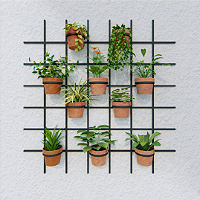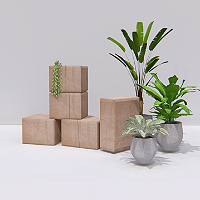Some days, your plant will seem like a complete mystery. It does well one day and poorly the next. If you’ve ever been in this situation before, you know how difficult it can be to pinpoint the source of the problem. There are several potential causes for the symptoms you’re seeing in your plant. This is a really trying situation to be in. Good thing there’s a way out of this!
The eyes may be the window to the soul, but a plant’s leaves may reveal much about its well-being. Leaves vary in response to environmental stresses including nutrient inadequacy, overwatering, high salt levels, and excessive sunlight. Let’s take a look at some of the most typical “leafy” symptoms, the issues they signal, and the solutions available.
Note: It’s important to keep in mind that most of these symptoms can originate from more than one source before proceeding.
So, how can you identify the root cause of the problem?
You examine each potential explanation and start eliminating them one by one.
Root rot, vitamin deficiencies, and a lack of sunlight are just some of the potential causes.
Find out what’s wrong with your plant quickly by eliminating likely culprits one by one.
Sometimes it’s hard to tell what a set of symptoms means, and that’s because they might signify so many different things. Please investigate each of the potential reasons for your plant’s symptoms thoroughly. By doing so, you can determine the disease plaguing your plant and take appropriate action.
Now we’ll talk about the different symptoms that your plants might face.
-
Yellow Leaves
What to look for;
Plants require nitrogen more than any other nutrient for survival, growth, and reproduction. Low nitrogen levels have a negative impact on every process in a plant.
The most visible indicator of nitrogen deficiency is the yellowing of the leaves, which usually begins in the oldest leaves and extends from there. Nitrogen shortage is commonly misconstrued since the entire leaf, including the veins, turns yellow; however, older leaves are the first to exhibit nitrogen deficit signs. Younger leaves, on the other hand, are the first to show signs of iron deficiency, with veins that are a darker green than the rest of the leaf.
Causes;
- Soil nitrogen levels may decrease after prolonged rain or an oversupply of watering.
- Nitrogen deficiency symptoms can also emerge in plants when cultivated in nutrient-poor soils with low nitrogen levels.
Cure;
- The addition of inorganic fertilizer containing nitrogen is the typical initial response to nitrogen-deficient symptoms. Quickly resolving the issue, this solution is short-lived, though.
- The most effective way to treat nitrogen deficit over the long term is to introduce organic nitrogen sources into the soil. This long-lastingly enhances the soil’s texture and water-holding ability.
- Another excellent organic source of nitrogen is blood meal.
Prevention;
- By far the most basic approach- if you have nutrient-poor soils, work with nature by using native plants that have adapted to thrive in nutrient-poor soils.
- If you’re not sure which nutrients your soil is lacking, you can have it tested by local experts.
-
Brown leaf tips or edges
What to look for;
We are all aware that eating too much salt is bad for your health. It has a deleterious influence on plants, as expected. Excessive salt levels hurt plants in a variety of ways. Salt intake produces browning of the leaf, which starts at the margins and advances inward until the entire leaf is affected. Excessive salts in the soil can dry up plant roots and make several vital nutrients, such as potassium and magnesium, unavailable to the plant.
Causes;
- Hot and dry air; The lack of rain in dry and semi-arid regions stands to reason, given how readily water leaches salt from the soil.
- Salt pollution is a concern in parts of the world where de-icing salts are frequently utilized throughout the winter.
- Plant spotted in an unsuitably heated environment.
- Spotted in areas with high relative humidity (86−100%) & temperatures between 16 and 36°C.
- Excess or under watering with root rot.
- Fungal Infection.
Cure;
- Repot with care
- Water the plant thoroughly, to a depth of one to two feet, so that the salt may be removed from the root zone.
- Cut out infected shoots with disinfected sewing scissors. Dab alcohol or bleach on each cut.
- Discard the brown leaves.
- Remove old topsoil from surviving roots.
- Soak healthy roots with antifungal. You can also mix 1 tablespoon of hydrogen peroxide with 1 cup of filtered water.
Prevention;
- If the plant doesn’t absorb the nutrients, the salts burn the roots and cause brown or black leaf tips. I recommend diluting the fertilizer by half.
- Keep the drainage holes in check.
- Purifier water contains a lot of salt, equivalent to too much fertilizer.
- Before using, let the water stand overnight.
- Place a humidifier near plants.
- Create a mini-greenhouse by grouping plants.
- Try plants on a wet pebble tray. Be watchful.
-
Curl, misshapen, and pale Leaves
What to look for;
Plants with a calcium deficit develop slowly and have a bushy appearance, with symptoms appearing first on younger leaves and tissues. The newest leaves are typically small and misshapen, with brown chlorotic spots that begin at the leaf edges and advance within, eventually gathering in the leaf cores. Ca-deficient plants have dark veins in their totally dead leaves, also in parachute-shaped leaves The surface of a leaf may also get crinkled and ripped. Phosphorus shortage normally begins at the plant’s base (on the oldest leaves) and rises if addressed.
Causes;
- Overwatering
- Pests infestation
- Nutrient deficiency
- Too much sunlight
Cure;
- Place your plant in a warm place with indirect sunshine to allow the soil to dry naturally.
- Leaving an overwatered plant with root rot to dry naturally might cause extra harm.
- Install fans to move heated air out and cold air in.
- Planting in new, unwatered soil
- Before repotting, remove rotting or mushy roots.
- Use organic solutions (mix of 2 cups of vegetable or Neem oil, mixed with water and a dash of liquid soap) in case of pest infestation.
- Spray weekly or after heavy rain.
- Pick a liquid fertilizer that contains all three NPK ingredients.
- If you suspect your plant is getting too much sun, place it in the shade for a few days and water it until it improves.
- Don’t pluck downward-curling leaves unless they’re dead or haven’t recovered.
Prevention;
- Let the top two to four inches (five to ten centimeters) of soil dry out before watering again.
- Keep your grow room between 18 and 28 degrees Celcius.
- Keep plants and lights well-ventilated and spaced.
This blog was written with the help of the resources shared in this paper-







